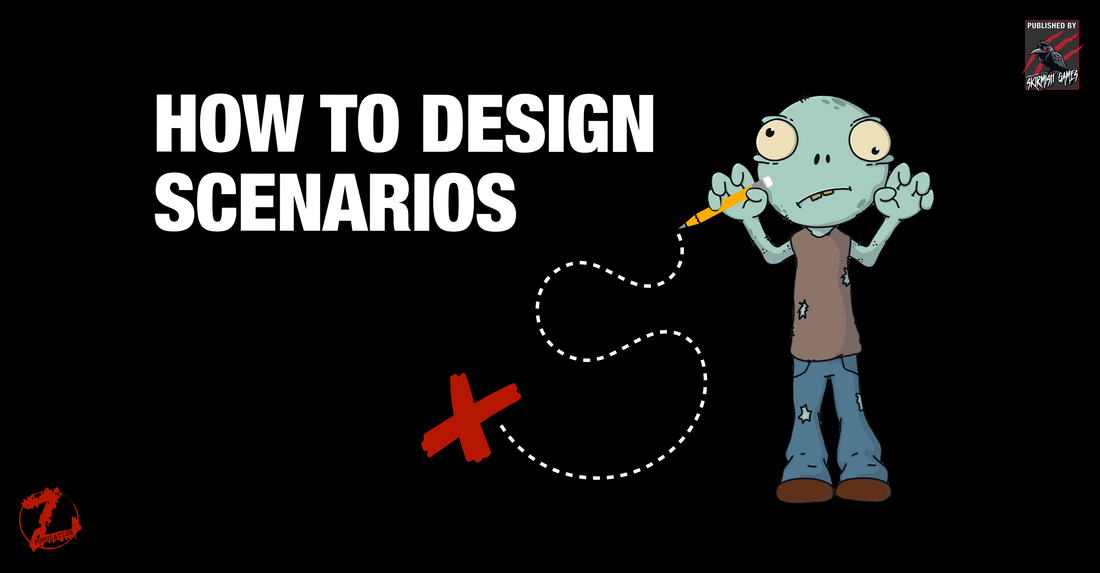How To Design Scenarios For Tabletop Skirmish Games
Creating scenarios is an essential part of tabletop skirmish game design. Scenarios provide players with a specific objective to achieve and add variation to gameplay. In this blog post, we'll discuss the importance of variation in tabletop skirmish games and how to design scenarios that maintain player engagement, enhance narrative immersion, and establish clear objectives.
Variation
Variation is key in creating an engaging tabletop skirmish game. Players want to feel like their choices matter and that there are different paths to victory. Designing scenarios with varying objectives, terrain, and deployment zones can help keep things fresh and exciting.
Including unexpected events or twists during gameplay can create memorable moments and add tension to the game. For example, in Population Z, you can take your Skirmishes up a notch by selecting a Weather condition from the Weather Table during the pre-skirmish sequence. Weather conditions can make specific actions more difficult, forcing players to develop alternative strategies. It's also fun to match the weather in the game to the weather outside your window. When it's raining outside, and you are playing a Skirmish with rain, you get some free sound effects!
Player Engagement
To maintain player engagement, it's important to design scenarios that have clear objectives. Players should know what they need to do in order to win and how to achieve that goal. This clarity helps players focus and make strategic decisions. Objectives can vary from destroying a specific enemy unit or NPC to capturing an objective marker on the board.
When players have boundaries, they can create strategies to work within them to achieve the objective. Adding a twist part way through a game, such as a new NPC entering the battle or a random environmental event, will prompt players to alter their plans, adapt, and overcome the new problems they face.
Narrative Immersion
To create and enhance narrative immersion, scenarios should have a story or theme that the players can follow and develop through their actions and outcomes. This can be achieved through the use of unique terrain, specific factions or characters, or even through the scenario objectives themselves.
For example, I'm working on a sci-fi special forces game (very early stages) and a scenario where a group of elite soldiers must rescue a hostage from enemy forces. Setting a finite number of rounds will create a sense of urgency during the mission, and the consequences can add to the game's overall story. If the special forces team fail to rescue the hostage, vital information is passed on to the enemy, which will make their next mission more difficult.
Campaign Progression
Campaign progression is another important aspect of designing scenarios. In a campaign, the outcomes of previous games can affect the next game. This creates a sense of continuity and allows players to see the consequences of their actions. Scenarios can be designed to affect the campaign in different ways, such as changing the availability of certain units or resources or even changing the campaign's narrative.
I approached Population Z as if each skirmish scenario was an episode in a TV show. Survivors have different objectives to achieve, and they'll meet new characters and NPCs each time. The consequences of each scenario impact the next, and players use the set boundaries of the core mechanics and skirmish rules to act out and tell their stories.
Skirmish Map
A good skirmish map can convey information clearly and concisely that is easy for the players to digest. The map must identify objectives, crucial terrain, deployment zones, exit points, spawn points, searchable areas, starting NPC placement, distances and measurements.
Spending time developing a system for your scenario maps helps with continuity as players learn the layout and mapping system, know what to look for as they progress, and play out new scenarios.
Win Conditions
Win conditions are also crucial in designing scenarios. Players need to know what they need to do to win the game. This can vary from destroying a certain number of enemy units to achieving a specific objective. Ideally, the win conditions should be achievable and challenging so that players feel a sense of accomplishment when they succeed.
As we discussed in the rulebook structure blog post here, layout helps inform players and keep the win conditions clear and concise. Bullet points are a great tool to tell players exactly what they must achieve to meet the winning conditions. You can include secondary objectives, and it's good practice to put those in a separate section with its own header and bullet points. That way, the main objectives and secondary objectives are well defined.
Play Testing
In a previous post, we discussed play-testing core mechanics here, but play-testing doesn't end there. Play-testing is essential to ensure that scenarios are balanced and fun to play. Play-testing allows designers to see how different factions and units interact with each other and identify any potential balance issues. Additionally, play testing can help designers see how players react to specific scenarios and objectives, allowing them to adjust as needed.
Play-testing is never-ending. When you develop a new scenario as an expansion, supplement, or even a new character or weapon, play testing is essential to ensure it works alongside the core mechanics, previous scenarios, and existing characters. It's so easy to make a new character that can be combined with an existing character to make an overpowered combination.
Finally, play testing is fun! The process is full of discoveries and problem-solving, and I've grown to look forward to and enjoy the play-testing sessions a lot.
How To Design Scenarios For Tabletop Skirmish Games
Overall, designing scenarios is vital to creating engaging tabletop skirmish games. By creating scenarios with variation, clear objectives, narrative immersion, campaign progression, challenging win conditions, and play testing, you can create memorable and enjoyable gaming experiences for your players.
As we get closer to the release of Population Z in January 2024, I'll create a step by step example of how I create a skirmish scenario for Population in a video and future blog post. I'll go through the decision making process, highlight play-testing discoveries, and much more.
I’d love to hear your thoughts and opinions on the subject, so join in the conversation in the comments below.
Thanks for reading!
Lee
Look out for my new game, Population Z: Welcome to Huntsville, launching in January 2024.

